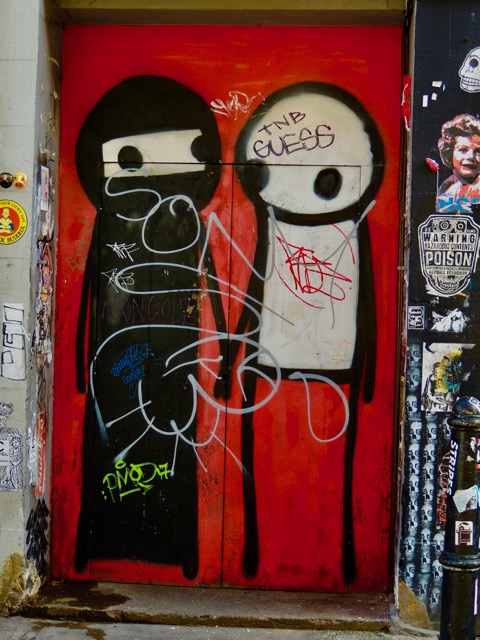Difference between revisions of "London Street Art"
From Londonhua WIKI
(→Painters' Paint) |
(→Recyclomaniacs) |
||
| Line 295: | Line 295: | ||
}} | }} | ||
The artists and work in this style are socially conscious and have a back to nature aspect to them. The materials they use are generally bio-degradable and craft-based. This style oftentimes brings our attention to street furniture that we would not notice otherwise. It will question the form and function of the objects that we regularly engage with. | The artists and work in this style are socially conscious and have a back to nature aspect to them. The materials they use are generally bio-degradable and craft-based. This style oftentimes brings our attention to street furniture that we would not notice otherwise. It will question the form and function of the objects that we regularly engage with. | ||
| + | <br> | ||
| + | <br> | ||
| + | <br> | ||
| + | <br> | ||
| + | <br> | ||
| + | <br> | ||
| + | <br> | ||
| + | <br> | ||
| + | <br> | ||
| + | <br> | ||
<br> | <br> | ||
Revision as of 20:04, 23 May 2017
London Street Art
by Olivia Gibbs & Emily Wilson
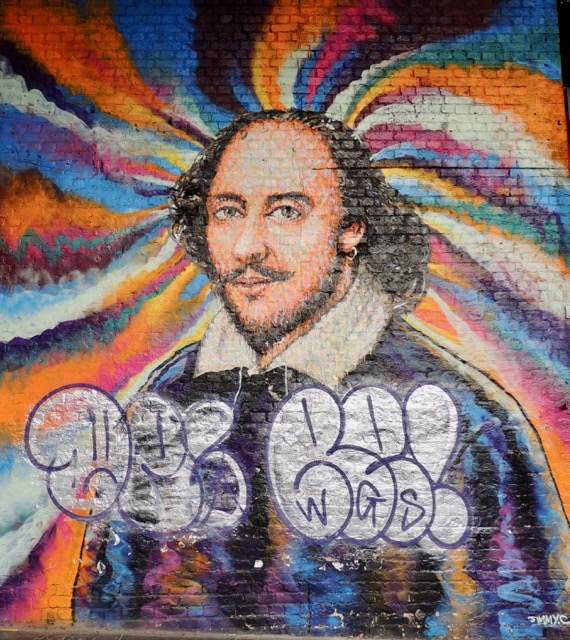 Art by Jimmy C, photo by Emily Wilson |
Contents
- 1 London Street Art
- 2 Abstract
- 3 Introduction
- 4 Section 1: Background
- 5 Section 2: Deliverable: Banksy Inspired Piece of Art
- 6 Conclusion
- 7 References
- 8 Attribution of Work
- 9 External Links
- 10 Image Gallery
Abstract
The paragraph should give a three to five sentence abstract about your entire London HUA experience including 1) a summary of the aims of your project, 2) your prior experience with humanities and arts courses and disciplines, and 3) your major takeaways from the experience. This can and should be very similar to the paragraph you use to summarize this milestone on your Profile Page. It should contain your main Objective, so be sure to clearly state a one-sentence statement that summarizes your main objective for this milestone such as "a comparison of the text of Medieval English choral music to that of the Baroque" or it may be a question such as "to what extent did religion influence Christopher Wren's sense of design?"
Introduction
I suggest you save this section for last. Describe the essence of this project. Cover what the project is and who cares in the first two sentences. Then cover what others have done like it, how your project is different. Discuss the extent to which your strategy for completing this project was new to you, or an extension of previous HUA experiences.
As you continue to think about your project milestones, reread the "Goals" narrative on defining project milestones from the HU2900 syllabus. Remember: the idea is to have equip your milestone with a really solid background and then some sort of "thing that you do". You'll need to add in some narrative to describe why you did the "thing that you did", which you'd probably want to do anyway. You can make it easy for your advisors to give you a high grade by ensuring that your project milestone work reflects careful, considerate, and comprehensive thought and effort in terms of your background review, and insightful, cumulative, and methodical approaches toward the creative components of your project milestone deliverables.
Section 1: Background
Defining Street Art and its Terminology
Street art has many loose definitions and is very hard to define. As quoted by street artist Nicholas Riggle, "The artist must willingly expose there work to the risks of defacement, destruction, theft, alteration, appropriation; in short must be committed to ephemerality.” That quote describes the basics of street art, and what is required of it, and it really embodies a lot of what is read in literature as a definition of street art. The next question is what defines good street? That is up to the viewer, it does not require a degree to be able to analyze it, the simple question is does the viewer find it interesting? Some elements that go into what can be seen as "good" street art is the color, the form, the skill in painting the image, the placement of the image, how it has weathered, the interaction with its surroundings, and how accessible it is to viewers.
In the world of street art and graffiti there is a lot of different terminology used throughout the process, here are some of the common terms used. We will be using these terms through out the page in order to explain graffiti and street art.
- Tag: A person's graffiti name, can be their actual name, can be letters that stand for something
- Throw-up: This is larger, rapidly written bubble letters that are quickly written on a wall
- Piece: A larger, mural-like design that uses multiple colors and complex techniques, usual put up by a group of people
- Slaps: Stickers, they get their name for their ability to easily be slapped up on a wall
- The Buff: When tags are removed by city authorities
History of Street Art
Graffiti refers to 'writing' which developed as youth subculture in the mid 1960s Philadelphia and grew explosively after reaching New York in the late 1960s.
Many factors in the New York 1960s time period lined up for graffiti to flourish including the urban renewal project that had replaced a lot of cheap working class housing with publicly financed middle class house and new roads, both of which led to the dramatic decrease in jobs for the unskilled workers which were mostly made up of the immigrant and poor class in NYC. Also, in the 1960s urban riots took place for radical movements such as Black Panthers which brought adolescents together to resist authority. These events elevated the reason for writers to do graffiti. The majority being from the poor class, they wanted to be seen.
Tagging started before 1967 when people would post their names in their neighborhood as a sign of their gang, but soon others broke out and realized they can become even more recognized if they start tagging their names in other parts of town. The sole purpose for their tags was to achieve recognition. In order to be quick and not caught, names were often under five letters. And writers never saw themselves as vandals or artists either.
As time went on and more and more people began to join, an increase in competition was seen. People wanted their names to be all over but were carful not to paint over another person's name as to avoid a fight. To increase status and fame, the more dangerous the location of your tagging the more points you received. This led to trains. Trains were and still are one of the hardest locations to tag, since they are constantly on the move and the train authorities have always been strict with no graffiti, so one had to be careful not to get caught.
Writers began to see themselves more as artists as tags became more thoughtful, creative and care was put into their design instead up just spraying up four letters. They tried to strategically place their tags in locations where they thought photographs would be taken so their tags can be share and spread widely. As Bofkin put it "..graffiti culture quickly institutionalized values such as hard work and creativity, which were necessary for any writer to receive acclaim." And by the 1970s graffiti crews began to form which small groups of friends who shared a passion for writing. These crews became better options for young teens to join instead of gangs. They were goal oriented, protective and they were places where writers can learn from each other.
Graffiti didn't reach Europe until the early 1980s as part of the hip-hop culture. Wildstyle and Style Wars were two movies produced in 1983 that celebrated the hip-hop culture and exported graffiti in masses in Europe. Most of the graffiti in the early 1980s in London was related to IRA (Irish Republican Army) or anarchic punk bands. However, much of its evolution mirrored the early day sin New York, where London writers painted on the outside of trains. Similarly, artists paint on Brick Lane for the known fact of tourists and photographers roaming the area they know their art will be seen by many.
The first recognized artist to be associated with street art as a specific movement instead of graffiti is Blex le Rat. Blex le Rat is a French artists who after his visit to New York in 1971, came back to Paris in 1981 and began stenciling rats on the walls. He believed stenciling suited his city better than graffiti did. He was the first, only with Jef Aerosol and Nick Walker who also stenciled in the 1980s, but the world famous and most influential street artists didn't come until the 90s.
Shepard Fairey, an American artists, began producing countercultural "Andre the Giant OBEY" stickers in 1989 which quickly caught attention and is now used for commercial products. Cost and Revs are a duo who began working together in the early 1990s where they posted their names and short phrases in Manhattan. It is in the turn of the century when contemporary street artists, including Invader and Bansky, artwork had come into light and are still seen today. Some of the first Londoner street artists were D* face, Mysterious Al, and Ronzo. These artists popped up in the early years of the 2000s, bringing in the culture that it is cool to paint walls and objects found on the streets.
Today, still, people question what defines street art. It originates from graffiti but goes far beyond just letters to now murals, stories, sculptures etc. A loose definition is simply art found outside, it is not on display inside a four roomed gallery and no money collection is required. Any one and everyone can view it or miss it if they are observant. It can make you laugh, smile, or think about what it is to be human in our modern world. But how is it created?
Materials and Methods
The aerosol can was developed in 1899 and it was a mixture of propellants that was used to create the aerosol. The cans did not have a good valve system however so it just sprayed the contents of the can out with no control. In 1927 Erik Rotheim was the first person to create a can with a functioning valve system. The major development of the can came in World War II when the Americans needed insecticides, so it was very important that the cans worked. The Continental Can Company Created the first push button can in 1946. Edward Seymour became the first person to put paint in a can in 1949. Spray paint was originally designed for household and industrial purposes, but it became the mean for graffiti artists. Writers played with the can such as using fat caps which are wide-spraying nozzles from other consumer products which allow writers to paint faster and larger areas. The first spray paint designed for graffiti writers was created in 1994 by Spanish company Montana. Today there are many more companies and some are even developing high-tech polymers that can protect street art murals against the elements for decades.
Some other materials today include chalk and stickers. Chalk can be seen as a temporary material as it more readily washes away over time and with weather. It is often used for street art done on the ground. This can be seen in front of the National Gallery by Freddy, and many other artists. Stickers are another medium used for street art. Because of there adhesive they can only be placed on metal posts or doors. Artists can chose to use this medium as a singular piece of art, by placing one sticker in a well-chosen art. They can also bomb an area with stickers, putting them up as many places as possible in a city.
There are multiple ways to create street art but it can be broken down into to categories, 1) reproducible and 2) free hand. Reproducibility is what is it sounds like, the capability to be reproduced over and over again. These forms of street art come from stencils and poster art that can be reproduced infinitely. Stencils are produced in a studio and then rolled out onto the wall and spray painted over. This allows an artist to quickly install detailed designed before getting caught. Stencils rarely use more than two colors because they can be hard to spray. This methods is often chosen by Bansky and is perhaps why his art is often simple black. Free hand art is closer to graffiti, as all the work takes place on the street scene. Free hand art usually is made of multiple colors because it is easy to switch between cans.
There is a life cycle to street art no matter or method is used. It goes up, and looks fresh and knew. Then it suffers from the elements. It can tear, stain, fade, and get marked by other artists. Then a new artists comes along and decides that is the spot for their new piece and the cycle starts all over again.
The Street is The Gallery
Working in the street allows an artist to reach a very large number of people. Street artist Nick Walker states, "The street is the biggest gallery you could ever want", and Eine stated,"You want to put your paintings where there’s going to be the most people traffic, where the most amount of people see it". Artist will spend a lot of time assessing the placement of a work of art. They will look at the street furniture and the urban architecture and see how it can help display their work of art. You will see that many artists work on recessed doors or in alcoves, this is because the surrounding architecture then forms a frame for their work. They look at the surface they have to deal with. For example stickers work better on metal posts, and while pasted on paper won't work on corrugated shutters spray paint will work there. Many times the interiors of derelict buildings have a lot of graffiti and street art in them. This space is popular not only because it minimizes the chances of being caught, but become some artists like the idea that only other artists will see it, or only some very adventurous explorers. Many people question if street art can be put into galleries. If you ask a street artist they will say that they believe the gallery and the street should co-exist, that they should not be mutually exclusive. When works by Banksy went up for auction it was quite an interesting experience. It was described as very posh people, in very posh places, buying artwork that features someone holding up their middle finger. In 2008 Tate Modern did an exhibit on street art, featuring street art on the outside of there building. This is a great example of street art existing both inside and outside of a museum. Cedar Lewisohn believes," The museums of the future may well be the cities themselves". Which all ties back to how the gallery for street artists is the street.
Graffiti versus Street Art
There are very few similarities between the two, they both often times use a spray can, and it often comes as a surprise to the owner of the wall. That is it for what is similar between the two. Graffiti is often compared to calligraphy and it involves writing letter sin various styles on walls. Graffiti writers remain focused on letters and words, writing their tags. Street art does not bound themselves in the same way. Street artists often have more tools and techniques at their disposal. Also if it is a legal, commissioned piece of work, they have time on there hands. Street artists can use paint, paper, even sculpted objects. There is often times a lot of tension between street artists and graffiti writers. The most well known confrontation between the two was between the popular street artist Banksy and a graffiti legend King Robbo. King Robbo painted one last piece before he went into retirement and Banksy used his painting man stencil to paint over King Robbos last remaining piece, that had been untouched by other graffiti and street artists. This brought King Robbo out of retirement and the two went back and fourth painting over each others works of art. Unfortunately one day while painting King Robbo had an accident and he passed away. In honor of him, and what you can say as the settlement of the argument, was a painting by Banksy in tribute to King Robbo. When looking at how people view the difference between street art and graffiti the difference is clear. Street art can be considered more user friendly, the general public tends to like it. Graffiti is more people writing graffiti for the sake of writing it, and the graffiti artist tend to not care of what people think of their tags. A quote from Street Art London States, "While street art shares DNA with graffiti, their outward appearance differs in some ways that makes street art marginally more acceptable to the general public and the authorities”. Street artists are far more likely to receive commissions to paint murals or be given the benefit of the doubt by police officers who could easily arrest them. Because of this street art is growing and becoming more popular, while graffiti is regarded as an indefensible crime, a social problem, and indicator of a world in decline.
The Legality
When you walk outside and see that an artist has decided to pick your wall to be their canvas there are a few different ways people handle the situation. One way is they find it annoying, and they simply call the council to have it removed. A second way is that they fear it, and what will come of it, so they call the police and have cameras installed to help deter it from happening again. Some people embrace it, they appreciate it and take pictures of it, posting them online for all to see. And some find it inspirational, depending on the subject matter it can move people. Graffiti is a criminal act in the United Kingdom that is punishable by up to two years imprisonment or a fine. A lot of the time this is flexible and the artist can spend half the time imprisoned and the other half doing community service. You can only be found guilty if you were caught in the act, so if your tag or name is on a wall you cannot get in trouble for it. The only way you will get in trouble is if you are standing at the wall with spray paint in hand. This is why graffiti is not very detailed, their tags, throw-up and pieces, need to take under 20 minutes in order to not get caught. This is where street art is really different, most artists work are legal. In order to do these intricate paintings the artist needs time, and therefore will ask permission from either council, or the property owner, if they can paint on their wall. Not all street artist follow this rule, and some have been caught in the act, but with sly talking, and familiar names have been able to get away with it.
Artists Thoughts
Christaan Nagel
Christaan Nagel wants to push the boundaries in the terms of what street art is. He is an exhibitionist, who gets inspired to the point where he feels rules don't apply and that he can take over the world. He believes he is the happiest person alive.
Connor Harrington
“I’m not much good at anything else and the slightest improvement is endlessly satisfying. I like creating new worlds, and painting is all about that”
Discreet
Discreet had always drawn character and cartoons since he was a kid. When he came into street art he wanted a character that he could make his own, and the reflected his personality. He tries to make sure his work is synchronized with the city. His goal is to create images that spark a conversation. When talking about street art he stated, “ The art works best in forgotten places with decrepit and disused places, places that most people consider lost”.
Jimmy C.
“The streets of London show a diverse range of local and international artists, and in certain areas the walls are changing on a daily basis. The walls are like an ever changing gallery; a continual dialogue. I am trying to add some colour through the visual poetry into the city through the portraits I paint, along with some essence of the human spirit.”
Pez
“ It motivates me to get to know cities, meet other artists and share my art with others, and give a part of myself to the streets.”
Roa
“Every time you realize an imagery in a public place you interact with its surroundings, situations and people. If everything comes together, then I personally feel satisfied. If I’m able to deliver something that adds to the place in a thoughtful way, I have fulfilled my own expectations.”
Styles
While it is not easy to classify every piece of street art, these are some styles that encompass a lot of them.
Suprematists
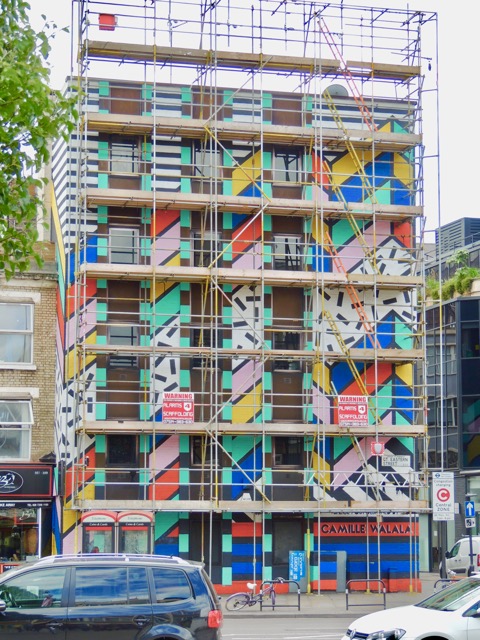 | |
| Artist | Camilla Walla |
|---|---|
| Location | Shoreditch |
| Caption | "" |
This style is when an artists takes the surface and decorative patterns into heavy consideration when choosing what to paint. It includes the use of angular forms, and straight lines, as well as placing primary and bold colors next to each other.
Site Specific Art
| Artist | Stik |
|---|---|
| Location | Brick Lane |
| Caption | "" |
This art is made for the environment it is existing in. Every piece of art has a story, and the location has a story, when you put the two stories together, you get a whole new story. It uses the site to enhance the artwork. In most cases, the spaces influence the art that is created for them. Street artists work with the urban features including cracks, pipes, and uneven surfaces. They incorporate living forms such as plants or trees. If the art is under a bridge many artists play with the structure itself and incorporate the beams or construction within their art. Many times with buildings faces can be made with the door as the mouth and the eyes coming out of the side windows.
Sci-Fi Expressivism
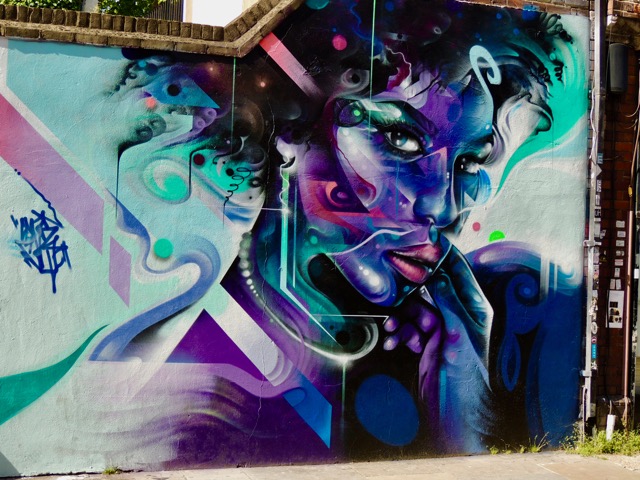 | |
| Artist | Unkown |
|---|---|
| Location | Brick Lane |
| Caption | "" |
It uses bold lines, making the image appear both retro and futuristic. The images painted are usually referencing the outside world, and use organic forms that describe nature or strange creatures.
Retro Pop
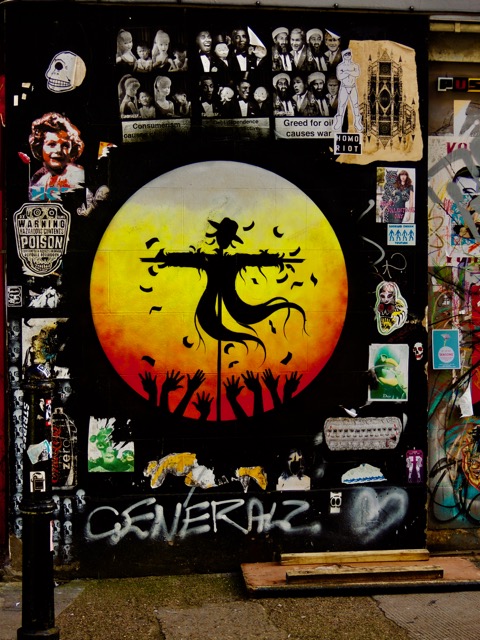 | |
| Artist | Shade |
|---|---|
| Location | Brick Lane |
| Caption | "" |
This style often uses bold outlines, graphics, and logos. Many times the meaning behind the work can have a dark reference.
Super Pop
 | |
| Artist | Invader |
|---|---|
| Location | Shoreditch |
| Caption | "" |
When people describe super pop, it is known as slick, sharp and ultramodern. The references many times have to do with computer games, including virtual reality and the digital age. There can be repeated patters that use bright colors, and it tends to give simple shapes basic human features.
Painters' Paint
 | |
| Artist | TBD' |
|---|---|
| Location | to find |
| Caption | "" |
When looking at these pieces of art it looks like there was a very strong emotional application of the paint, because of the abundance of drips, and colors bleed into one another. They use very large color field, and the pieces of work can look degraded or corroded even when they are first made.
Recyclomaniacs
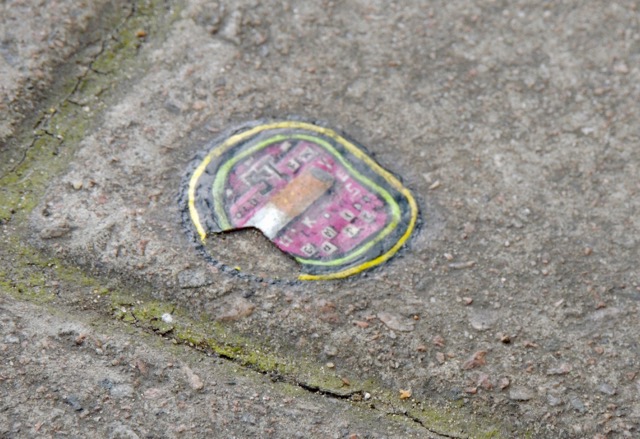 | |
| Artist | Ben Wilson |
|---|---|
| Location | Whitecross Street |
| Caption | "" |
The artists and work in this style are socially conscious and have a back to nature aspect to them. The materials they use are generally bio-degradable and craft-based. This style oftentimes brings our attention to street furniture that we would not notice otherwise. It will question the form and function of the objects that we regularly engage with.
No Logo
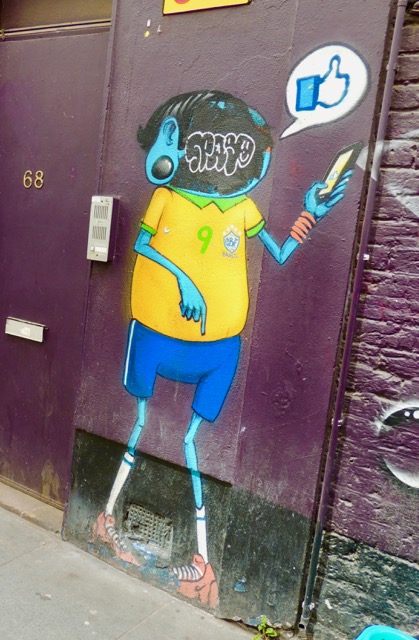 | |
| Artist | Cranio |
|---|---|
| Location | Shoreditch |
| Caption | "" |
In this style artists look for corporate locations that they can use for the "wrong" purpose. These works of art force us to think about our engagement with the world, and what consumerism is. The artists goal is to take back power from the authorities that impact our day to day lives.
Conceptualism
 | |
| Artist | TBD |
|---|---|
| Location | to find |
| Caption | "" |
This style is when the artist is conscious of their own production, and the production of the work is also the subject of the work. This style shows what it means to make street art and graffiti and how it is judged.
Section 2: Deliverable: Banksy Inspired Piece of Art
In this section, provide your contribution, creative element, assessment, or observation with regard to your background research. This could be a new derivative work based on previous research, or some parallel to other events. In this section, describe the relationship between your background review and your deliverable; make the connection between the two clear.
Gallery
Conclusion
In this section, provide a summary or recap of your work, as well as potential areas of further inquiry (for yourself, future students, or other researchers).
References
- Backstory: A London scene set by guerilla art; All around the city, street artists are stopping people in their tracks ... and thoughts. (2007, January 9). The Christian Science Monitor.
- Banksy, R., Banksy, R., & Banksy, R. (2005). Bansky: wall and piece. London: The Random House Group Limited.
- Bofkin, L. (2014). Concrete canvas: how street art is changing the way our cities look. London: Cassell Illustrated.
- Ilfeld, E. J. (2012). Beyond contemporary art. London: Vivays Publishing.
- Lewisohn, C. (2011). Abstract graffiti. London: Merrell.
- Malt, F. S. (2016). Street art london. Place of publication not identified: Dokument Press.
- Schacter, R. (2013). The World Atlas of Street Art and Graffiti. Kensington, NSW: New South Books.
- Street art: painting the city: London, Paris, Madrid. (2008). London: Tate Media.
- Young, A. (2016). Street art world. London, UK: Reaktion Books.
Attribution of Work
For milestones completed collaboratively, add a section here detailing the division of labor and work completed as part of this milestone. All collaborators may link to this single milestone article instead of creating duplicate pages. This section is not necessary for milestones completed by a single individual.
External Links
If appropriate, add an external links section
Image Gallery
If appropriate, add an image gallery
